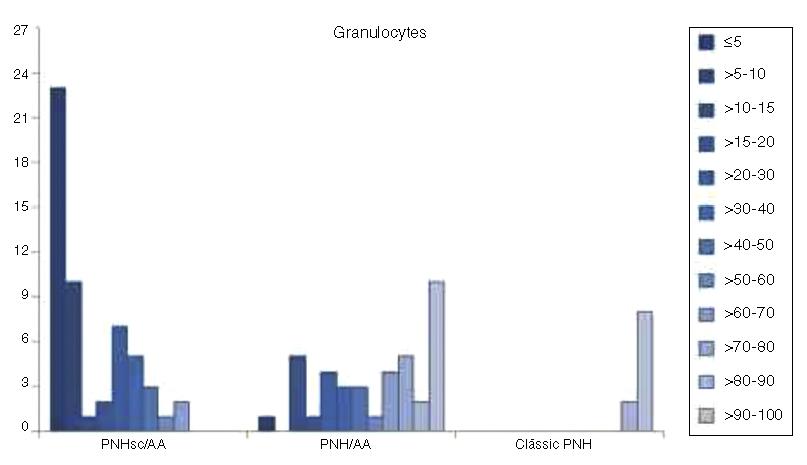Background:
Paroxysmal nocturnal hemoglobinuria is an acquired chronic hemolytic ane- mia, which often manifests as peripheral blood cytopenias and thrombosis.
Objective:
The aim of this study is to describe a Brazilian population of paroxysmal nocturnal hemoglobinuria patients.
Methods:
One hundred and three paroxysmal nocturnal hemoglobinuria cases were retrospectively reviewed and the clinical presentation, thrombosis, survival, and clone size were assessed. Diagnosis was established by flow cytometry.
Results:
Fifty-two male and 51 female patients with a median age of 24.1 years (5.5-62 years) were studied. Clinical symptoms included hemoglobinuria (18.4%), infection (46.6%) and thrombosis (16.5%), and 80.6% had pancytopenia. Patients were classified as classic parox- ysmal nocturnal hemoglobinuria (10), paroxysmal nocturnal hemoglobinuria with aplastic anemia (39), and paroxysmal nocturnal hemoglobinuria with subclinical features and aplas- tic anemia (54). There were significant differences in terms of median age, size of clone, clinical symptoms, and peripheral blood cell counts between the three subcategories. The clone size in erythrocytes and granulocytes were respectively 0.04% (range: 0-18%) and 7.3% (range: 0.3-68.7%) in patients with subclinical features and aplastic anemia, 15.8% (range: 0-99.7%) and 63.0% (range: 1.7-99.8%) in patients with aplastic anemia alone, and 82.2% (range: 0-99.85%) and 98.0% (81.3-100.0%) in Classic disease. Statistical differences were identified for platelets (p-value = 0.001), lactate dehydrogenase (p-value = 0.002) and the clone size (p-value < 0.001) in patients who suffered thrombotic events compared to those who did not. Overall survival was 81.7%, with patients with subclinical features and aplastic anemia having lower overall survival (76.5%).
Conclusion:
This retrospective review of 103 patients over an 11-year period represents the largest collection of paroxysmal nocturnal hemoglobinuria cases from a single center in Brazil. Flow cytometry showed that a larger clone was associated with classical symptoms and increased risk of thrombosis, even in patients with bone marrow failure, whereas a smaller clone was associated with bone marrow aplasia.
Hemoglobinuria Paroxysmal; Bone marrow diseases; Flow cytometry



